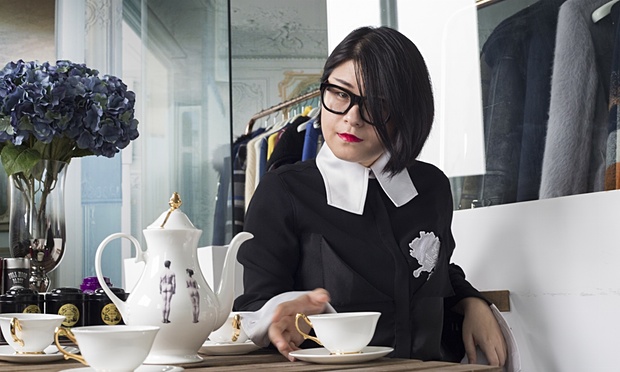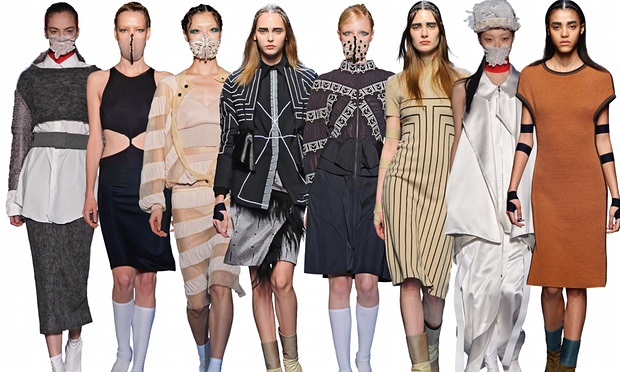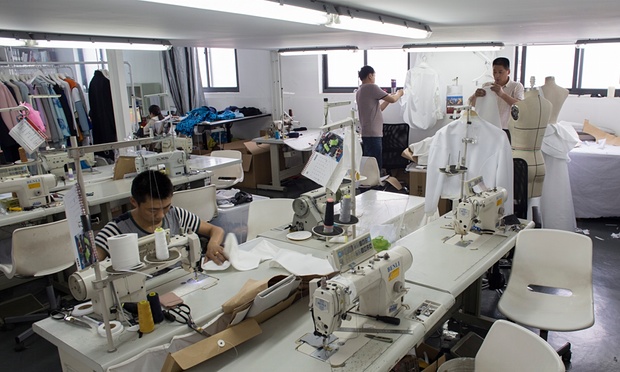Fashion design in China: ‘The trick is to embrace the chaos’
伦敦艺术大学广州招生代表处 | 2015-08-14
Fashion design in China: ‘The trick is to embrace the chaos’
Masha Ma 十六岁远赴英国留学,2006年毕业于中央圣马丁艺术学院获得女装设计专业学士学位,并继续攻读女装设计硕士学位。如今,Masha Ma 作为年轻一代设计师已引起业界的关注,她亦成为了巴黎时装周上官方唯一的一位中国设计师。

‘My inspirations come from both China and Europe. I spent 13 years in London and Paris’: Masha Ma in her Shanghai studio. Photograph: Jonathan Browning for the Observer
One evening in the mid-1990s, Masha Ma lay in her bedroom in Beijing and pored over a Chinese edition of Dante’s Inferno featuring Botticelli’s early illustrations. It disturbed her, and not just because she was 12 years old at the time. “The Chinese translation made the text sound like a happy Sunday outing, but the drawings depicted a bloody nightmare,” says the Central Saint Martins graduate who is now China’s most celebrated young fashion designer. “I stared at the pages for hours trying to understand what was going on. Something was very wrong.”
We’re sitting in Ma’s Shanghai studio drinking jasmine tea served from a pot adorned with a naked couple. The new building is at the northern end of the Bund, the city’s grand old promenade overlooking the famous futuristic skyline across the Huangpu river. It’s a suitably prime spot for a designer who is poised to become the country’s first international design superstar. Ma is revolutionising the global image of Chinese haute couture with her startlingly modern and clever creations, and there’s not a dragon or phoenix or a potential pizza meme in sight.
Although she is still relatively young – she turns 30 later this year – it’s taken a while. The Dante episode confirmed her early suspicions that a gap existed between the knowledge available to her in her homeland and in the world beyond. Post-Tiananmen and pre-internet, China was in the grip of far tighter restrictions on foreign cultural influences than it is today. Beijing-born Ma, the only child of academics, knew she had to go elsewhere. And if it happened to be a place where manifestations of hell, creative or otherwise, were more explicit, that was fine with her. “I’ve always been attracted to the darker side of things.”
She chose London. At the age of 16, Ma won a place on the foundation course at Central Saint Martins and spent the next seven years there doing BA and MA degrees. During her studies she worked as an intern with Alexander McQueen – her first fashion idol – and Veronique Branquinho. After a successful graduation show, she started her own Masha Ma label and launched her acclaimed debut collection in Paris in 2012. Naomi Campbell, Georgia May Jagger and Lady Gaga have worn her designs. In March this year, British Airways unveiled a new aircraft featuring livery it commissioned from Ma to mark Sino-British cultural ties. The design is a red rose intertwined with bamboo snaking along the Boeing 777-200’s side, with Ma’s signature beside it. “My name is on a plane,” she says as though the thought has just struck her. “That is crazy.”
The two years since she returned to China in early 2013 have left little time for reflection. She has set up a design studio with more than 50 staff and launched a younger retail line, MA by MA, featuring sporty feminine styles aimed at the burgeoning ranks of style-minded urbanites. She has opened two MA by MA boutiques in Shanghai, the country’s fashion capital, and plans to open around 100 more in China and elsewhere. And that’s on top of producing her regular catwalk collections for Paris Fashion Week, where she has shown eight times so far.
“When I came here I had nothing, not even a pair of scissors,” says Ma. She speaks in a refined British drawl with a few serrated edges of her native tongue, like a polished razor. “I didn’t plan to return so quickly. It was more like the gods dragged me back. But this is the new China. Things happen super-fast.” Huddled on a black pleather armchair in her private office, she is not wearing one of her own exquisitely cut designs today. She’s dressed in black leggings and high-top trainers – a show of surrender, along with the rest of us mortals, to the monsoon-like rain that has pounded Shanghai for three days straight.
Ma is now in a position to subvert stereotypes about China and Chinese style simply by being herself. Garish cultural references such as dancing lions or dragons, she says, are meaningless to her. “I have nothing against them, but they were never part of the Soviet-like China I grew up in.” For at least a decade after she was born in 1985, the benefits of post-Mao economic freedom still hadn’t filtered down much to the masses. “Everything was very grey, very uniform. Whether you were a party official or a factory worker, everyone wore the same drab clothes and used the same cups and had the same pattern on their sofa.”
Ma’s parents often worked overseas, so she grew up mostly with her grandmother, who was born in Shanghai before the communist era. The city was then China’s arts, jazz and fashion hub. Ma’s grandmother never lost her love of the finer things. “She always needed something beautiful in her life. I remember she had this little jewellery box that she probably risked her life to save during the Cultural Revolution.” At the height of Maoism, until the mid-1970s, any form of personal adornment was banned. “There was a Chanel flower brooch and pearl necklaces, and all these soft, feminine things. My grandmother always woke up singing, and she forced me to play the piano. She was a huge influence.”
The art deco edifices that survive in Shanghai are now dwarfed by steel-and-glass symbols of Chinese new money, including a skyscraper that, according to a map I picked up at the train station, is “designed to look like raw diamonds”. But Ma says being back in the city of her grandmother’s birth keeps her close to her spirit. “If I have to describe the type of woman I design for, it’s her: someone who never shouts for attention, but who refuses to be silenced.”

East meets west: Masha Ma has shown at Paris Fashion Week eight times, including these designs for spring/summer and autumn/winter 2015. Photograph: Getty
Chinese women were ready to listen. After Ma became one of the few mainland-born designers ever to be invited to show at Paris Fashion Week – still the ultimate destination for any designer – media coverage about her at home exploded. Initial support came mostly from the small but powerful high-fashion elite led by Angelica Cheung, editor-in-chief of Vogue China, whose imprimatur is everything.
Cheung’s circle has been championing homegrown designers for almost a decade, including Uma Wang and Qiu Hao, two earlier graduates of Central Saint Martins whose designs are lauded internationally.
Such efforts laid the groundwork for a broader shift in taste that coincided with Ma’s homecoming. After years of consuming foreign luxury brands to beyond saturation point (Louis Vuitton toilet-roll covers aplenty), fashionable Chinese had begun to seek out a more discreet, sophisticated aesthetic. Conspicuous consumption among the super-rich – dubbed the Bling Dynasty by banker-turned-author Erwan Rambourg – had also swiftly become passé thanks to a ferocious government crackdown on corruption. Ma’s designs tapped into the current mood. “Masha Ma is the perfect fusion of subtle class and edgy femininity for the modern woman,” enthused a recent issue ofElle China. “She is fast becoming a superstar at home and abroad.”
The thick wedge of hair that obscures the left side of Ma’s face is distracting at first, like talking to someone who’s constantly turning their head away. Still, the style suits her. She accepts that her presence in China is inevitably turning her into a pin-up girl for Chinese design, but she’s ambivalent about it, too. “I don’t like lazy categorisations. My inspirations come from both China and Europe. I spent 13 years – almost half my life – in London and Paris. In that time I came back to visit China only once, after the first six years. Beijing was so different I couldn’t find my way home. It’s meaningless to label me a ‘Chinese designer’ as though that’s what defines me.”
Predictably, London astonished her when she arrived as a teen in 2000. “I was so young. I couldn’t believe that so many different elements could coexist. There was a queen who looked like she always wore the same hat and all this polite tradition. And then all this crazy music and dynamic creativity and intellectual debate. It was like this beautiful clash.”
Ma threw herself into the fashion-student lifestyle, hanging out in galleries and greasy spoons and going to gigs. “I was into grunge and obscure garage bands. I also went to classical music concerts whenever I could.” She read everything she could find, from mythology to philosophy to Roland Barthes, and relished Central Saint Martins’ place in the nation’s artistic life. “The college had a plaque saying the Sex Pistols had held their first concert there, and we used the same scratched table to design that McQueen and Galliano had used. The toilets smelled of pee. But it was all so alive – you could feel a great sense of history and British culture.”
Ma says her time in the capital was invaluable. “London taught me that chaos is vital. All countries have problems, but the trick is to embrace the chaos and try to find a balance. If everything is the same and super-organised – how boring is that?” By the same token, she adds, it’s thrilling to be in China now that the nation is in such a dynamic state of transition. There’s a chance “to write history every day”.
Boundaries, on many fronts, are eroding with the rest of the world, and the country is becoming much more globalised. “The quest to find the essence of modern China concerns every creative person here. It’s very exciting. But it’s not a political mission or something we should be expected to deliver just because we’re Chinese – it has to come naturally.”

Cutting edge: inside Masha Ma’s Shanghai studio. Photograph: Jonathan Browning for the Observer
Ma says she is inspired by the “more mysterious, forgotten” aspects of Chinese history and philosophy, and how they resonate in contemporary life. Her latest collection in Paris in March featured geometric designs and rich earth colours partly based on ancient ideas about nature and the principles of classical architecture. She mixed angular shapes with soft fabrics, and classic silhouettes with rough textures. She sent her models down the runway to an eerie, contrasting soundtrack of urban techno that she composed herself.
“Europeans who saw the collection thought it was very Chinese. But Chinese people thought it was very European,” she says. “That was exactly the reaction I was hoping for – that kind of cultural confusion. I’m not interested in creating superficial collages by just adding various influences. I want to create something wholly new. I’m not saying I’m there yet, but the possibilities seem to exist.”
The cut of her designs is the key element for her. Ma taught herself pattern cutting in her teens from a book that her father brought back from Japan. “It was a method that required an almost psychotic level of precision. It was tough to master, but it enabled me to add depth and originality to the structure of my pieces.” Central Saint Martins was less dogmatic about technical skills, she says, but she learned almost everything else there. She credits the brilliant Louise Wilson, then head of the college’s MA course, who died last year: “Professor Wilson encouraged me not to be afraid of things that seemed abnormal or weird. She gave me total freedom to try new ideas.”
In her early teens, Ma won awards for classical painting. Her family assumed she would be an artist. She chose fashion instead after reading a copy of Elle China. “I suddenly realised that fashion has its own specific language, its own way to communicate. It was similar to art but less introspective. Fashion has a utility and charm that can bring beauty into people’s lives in a practical way. That appealed to me, as I’m a person who likes to find solutions.”
Fashion’s impact on people’s lives, as Ma sees it, is also how she rationalises the problem of Chinese political repression. Her return to China in 2013 coincided with the inauguration of President Xi Jinping. As well as launching his anti-corruption purge, Xi has cracked down heavily on public dissent and internet freedom. Ma is not interested in turning her work into a form of protest. “Of course there are big problems, but I don’t think standing around shouting like it’s 1989 all over again is the right strategy. People of my age or younger don’t have that fear of history in our DNA. We want to keep moving forward in any way we can.”
Ma is too smart to think fashion alone can compensate for the lack of political freedom. But she does believe in its power to foster self-expression and confidence. She often posts encouraging messages to her 190,000 mostly female followers on Weibo, China’s version of Twitter, such as “Don’t hesitate to say what you think” or “Be yourself, you don’t have to fake anything.” Cynthia Zhang, Ma’s 26-year-old assistant, says Ma’s designs empower younger Chinese women by showing them that clothes don’t need to be uncomfortable to be feminine. “You can be cool and relaxed, and dress to please yourself.”
Ma travels to Paris, where she has an office, at least once a month, as well as to New York and London a few times a year. It’s a gruelling schedule on top of the goal she’s set herself to build China’s first truly international designer brand. She relaxes mostly by reading – anything from gardening magazines to Kafka. She also has a two-year-old Corgi called Pillow (he looks like one) that she says is “her experiment in being a human”. She lives alone, and owning a dog forces her to think about the needs of something other than herself or her work.
For all her passion and loquacious intensity – she has talked at high speed for two hours solid – Ma seems remarkably cool and grounded. She tells me that Alexander McQueen’s suicide in 2010 made her ponder her own compulsion for perfectionism. “Lee’s death was horribly sad, but it wasn’t a complete surprise. It was there in his work; he was always on that fragile edge of life and death.”
Afterwards Ma decided her own career aim was “not be to the best, just to be better”. It’s a mantra she says she’s stuck to since. “Fashion at this level is brutal. But if you have that goal to keep improving, if you always give yourself something to work towards, I think you’ll manage to stay alive.”
Sources Link: http://www.theguardian.com/fashion/2015/jul/12/fashion-design-in-china-masha-ma-shanghai